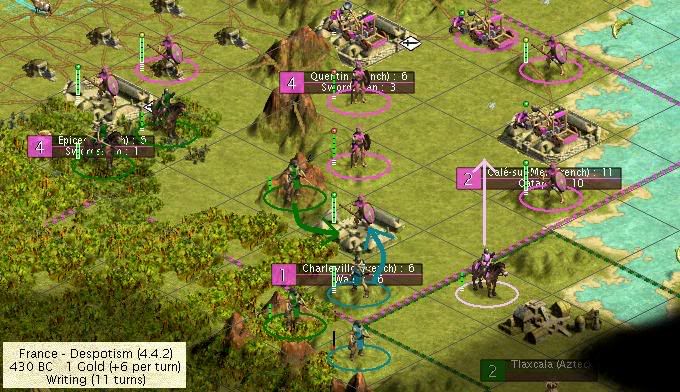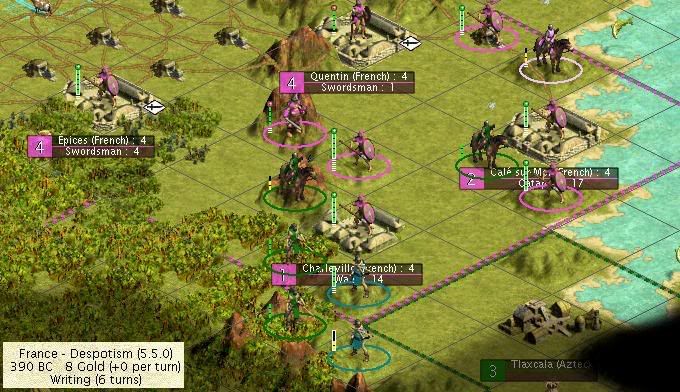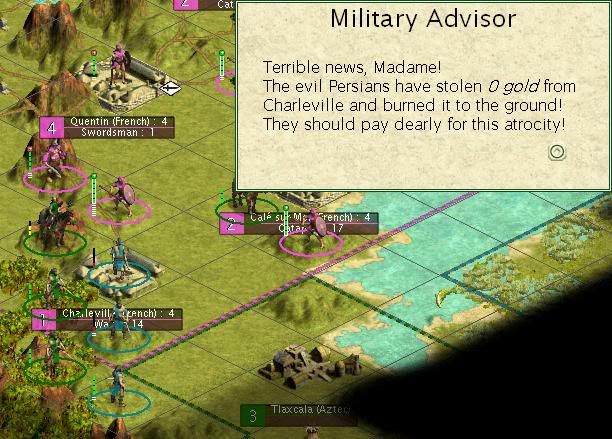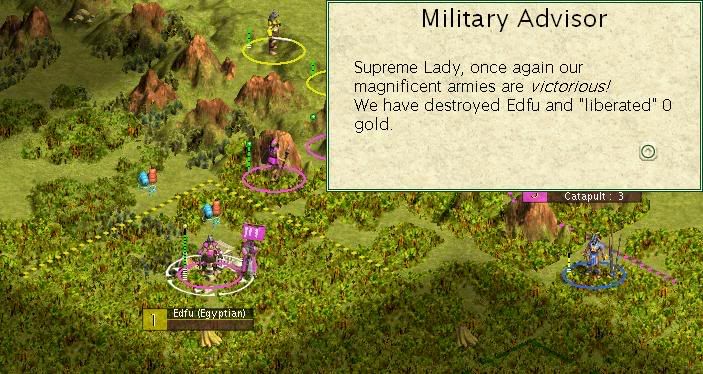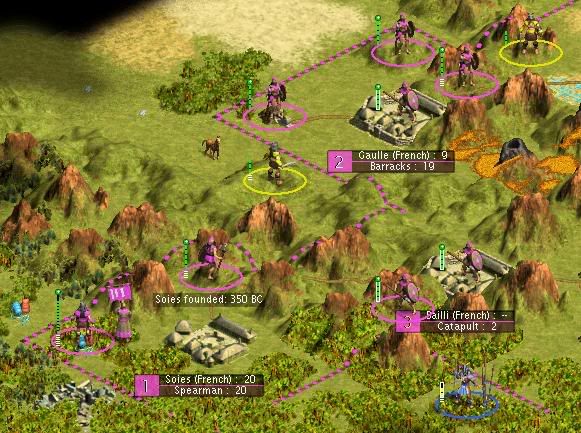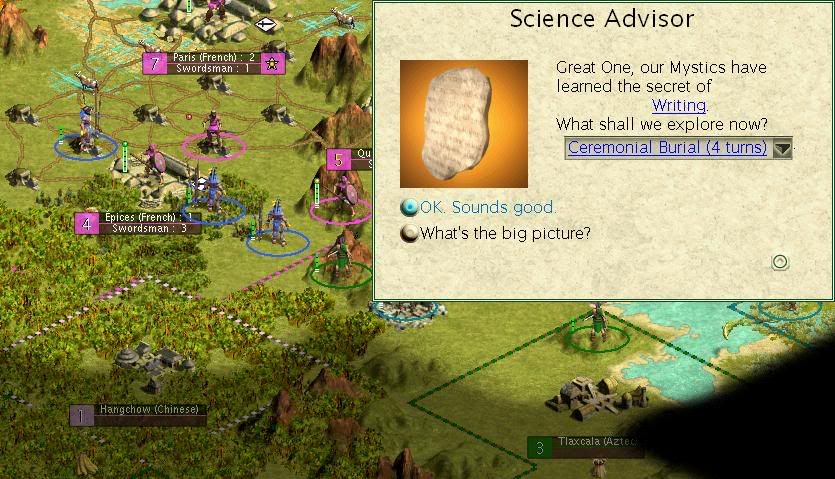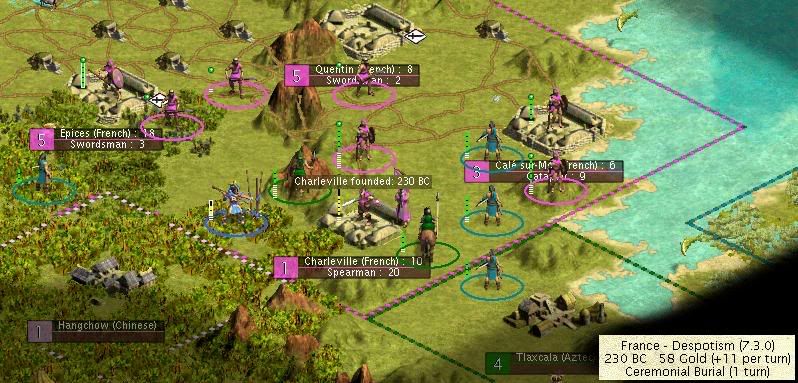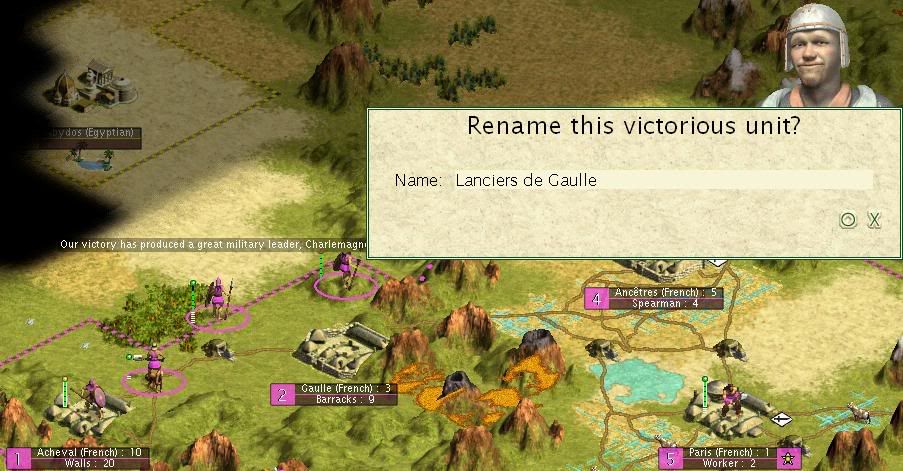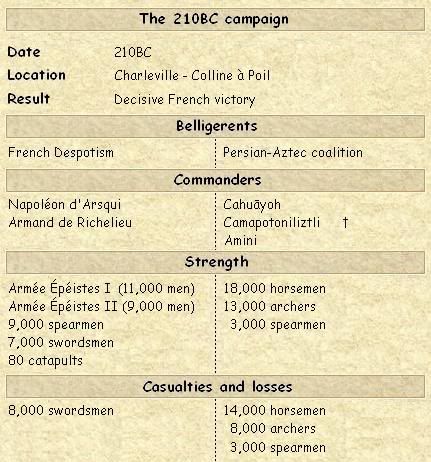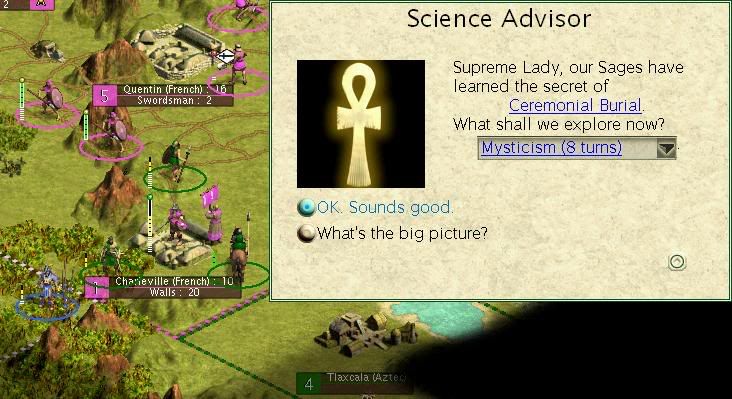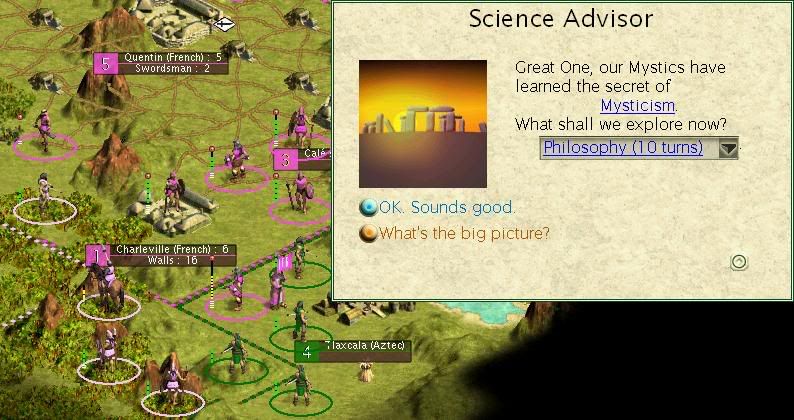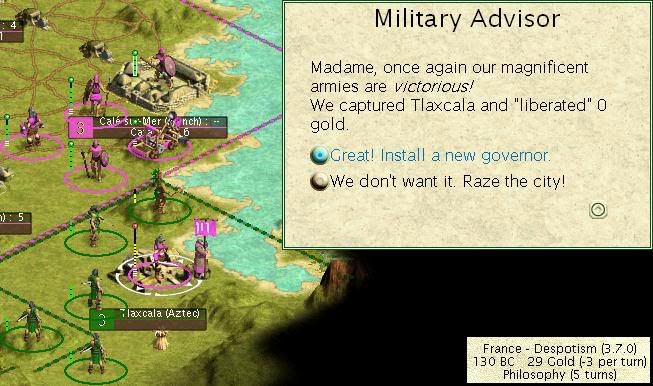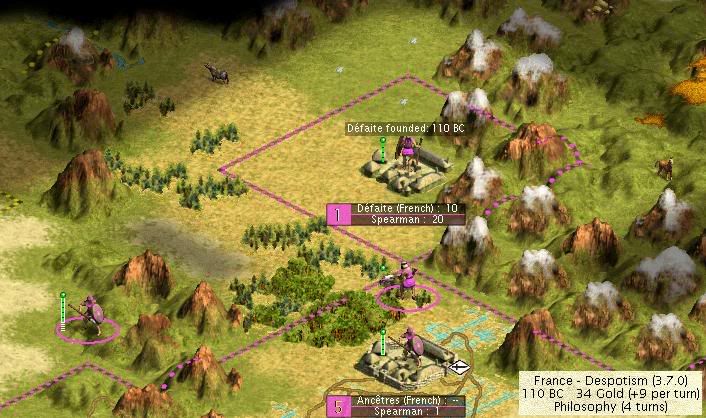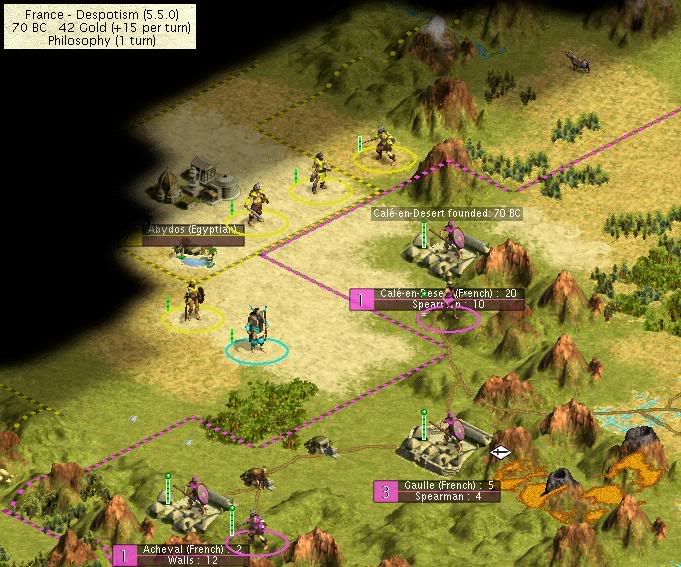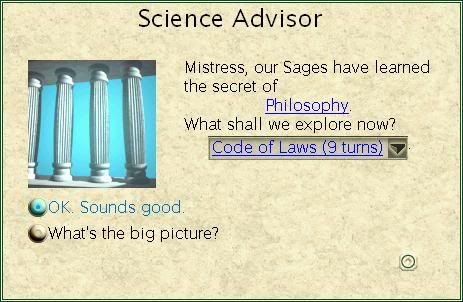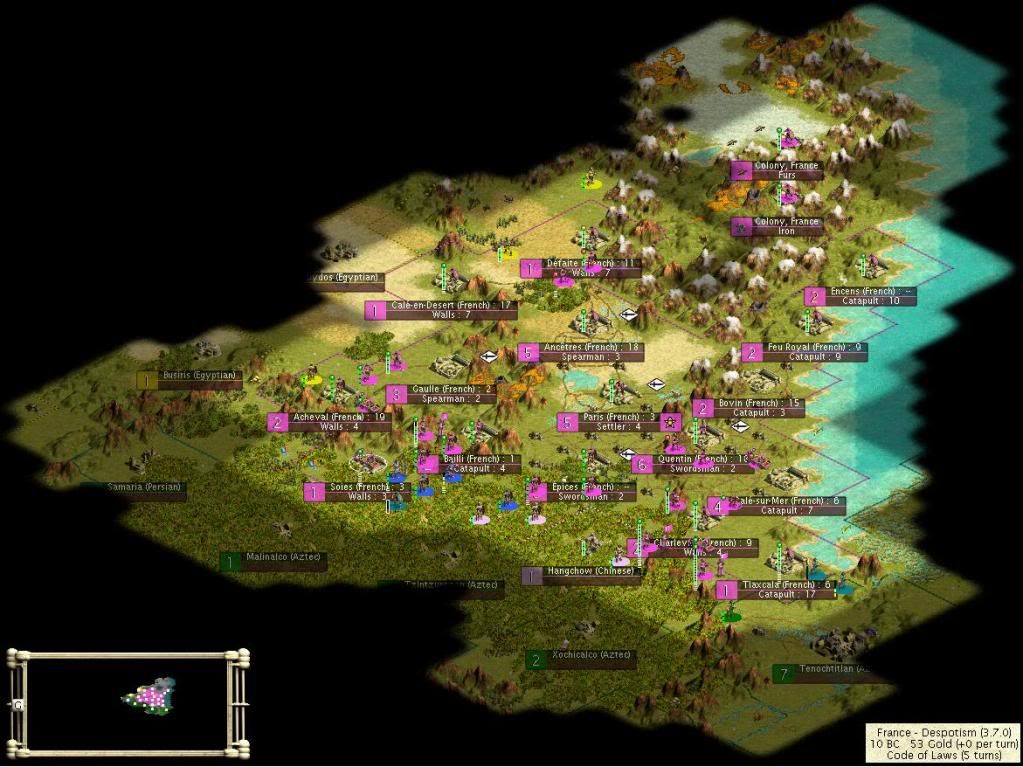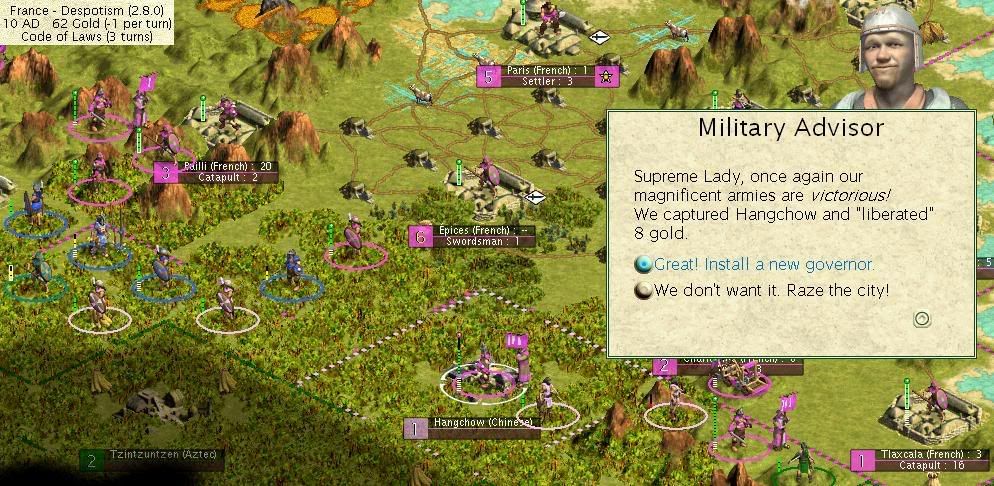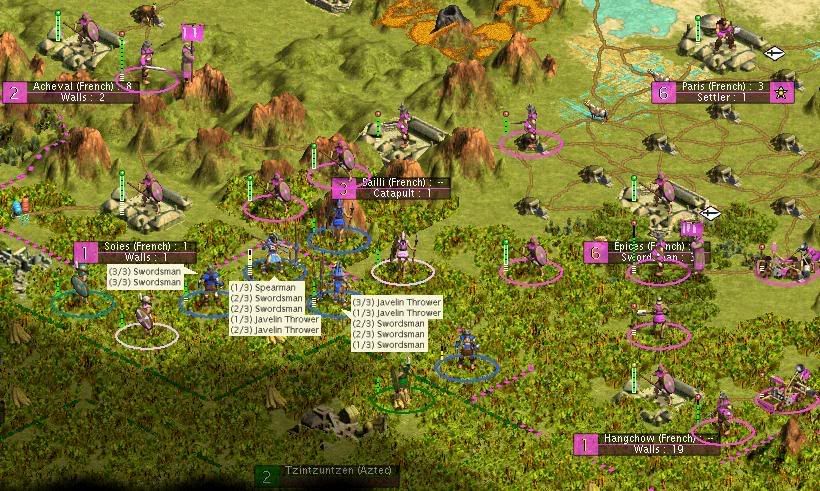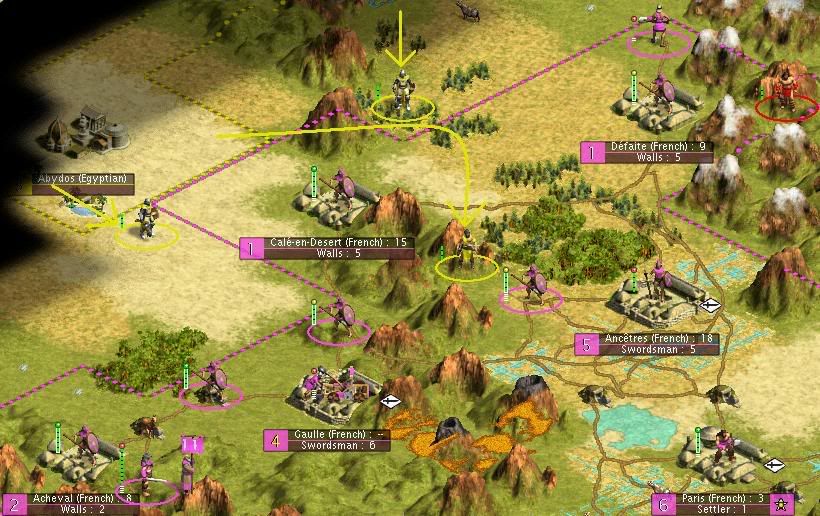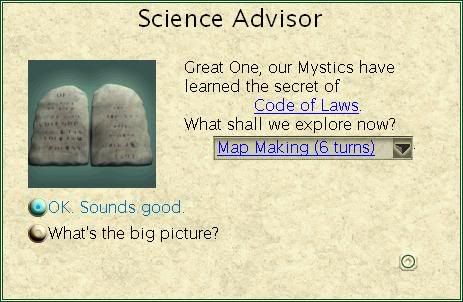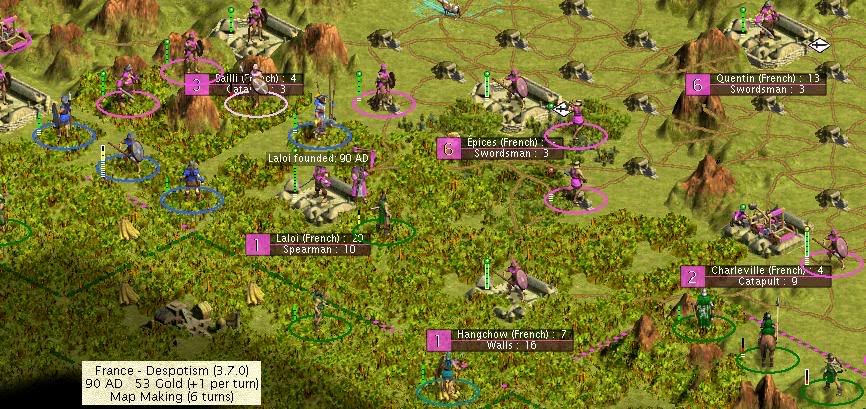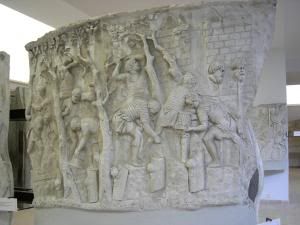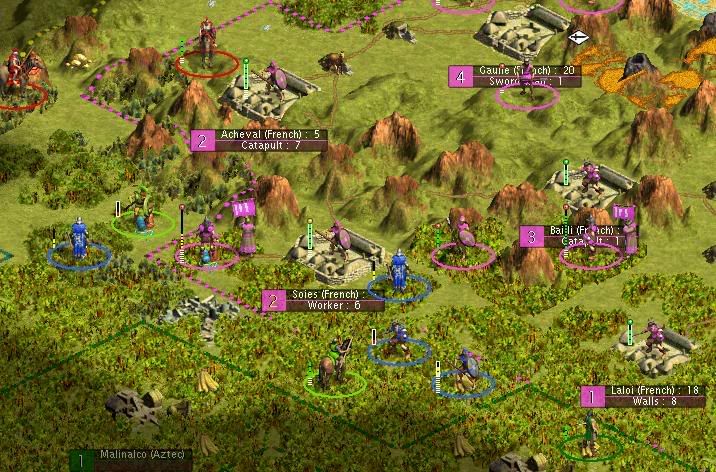Mumpulus
King
The history of France from the year 1100BC to 590BC is a little hazy. Tales of what happened during that period were somehow lost in the memory of the poets. That is why this era is called the First Dark Age.
We know that the period from 1050BC to 750BC was one of rapid territorial expansion. Bailli was founded by Épicier settlers in 1050BC, on the hills overlooking Valbovin. It was the first of four new settlements that would be established in fast succession. The other three were Feu Royal, Encens and Calé-sur-Mer.

[size=-2]Feu Royal was founded in 925BC, on the flanks of Mont Royal and on the board of the eastern ocean[/size]

[size=-2]Encens was founded in 800BC, even further north, in the hills where the incense had been found 450 years earlier[/size]

[size=-2]Calé-sur-Mer was founded in 750BC, wedged in between the Aztec realm to the south and the ocean to the north[/size]
There was also more exploration, especially by the Lancier Épiciers.
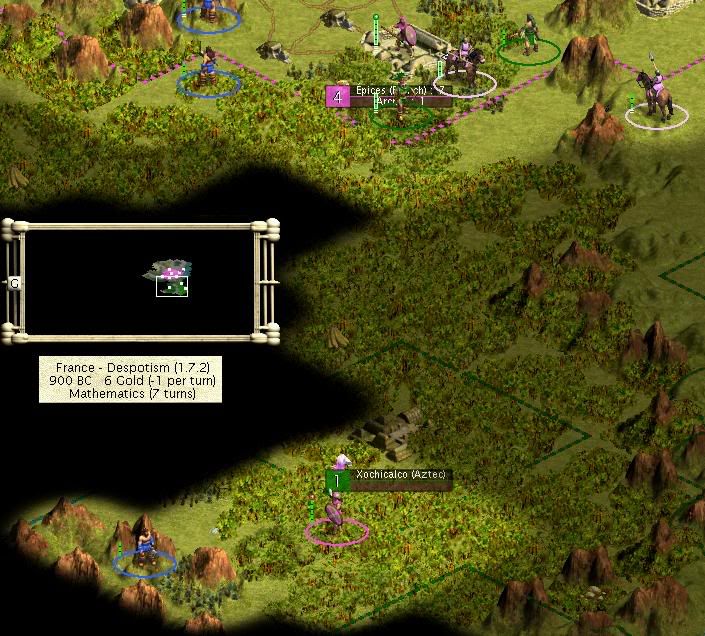
[size=-2]Dyes were found near Xochicalco in 900BC[/size]
This expansionist push was possible in part because the influx of enemy units declined during this period. There was continuous fighting, but by then the French military was so well entrenched that the enemy posed no real threat. The only reported loss during this period was a spearman division in the forest near Ancêtres, which was overrun by an Egyptian war chariot.
In 730BC, our knowledge of mathematics was sufficiently developed to build the first catapults. Even though the very first trial on a Persian spearman division failed miserably, more catapults were deployed and they quickly helped to gain an even greater edge on the enemy.
The Wheel was researched in 630BC. The horses that were found in the Chaîne des Loups and north of the Collines de Bailli would soon be put to good use. Research on Horseback Riding was started.


[size=-2]View of the Collines de Bailli in 630BC[/size]
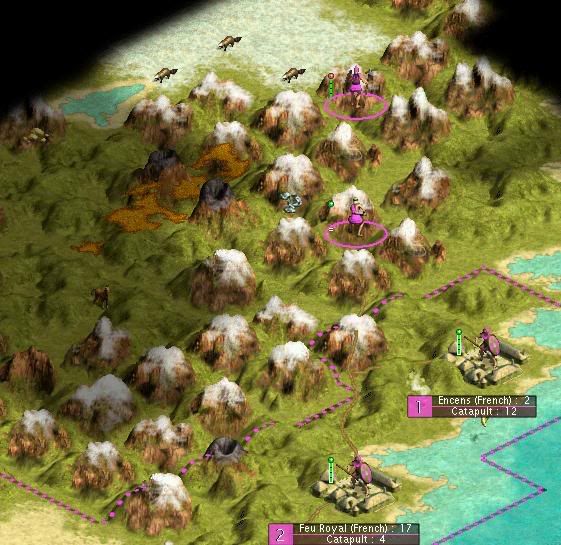
[size=-2]Furs were found just north of the iron deposits[/size]
Starting in 670BC, the fighting intensified again. The French were getting ready to expand again, and their generals were making room for that expansion. In 590BC, the Gardiens du Despote killed an Egyptian archer in a daring move. Their leader, Armand de Richelieu, was granted command of the second French army.
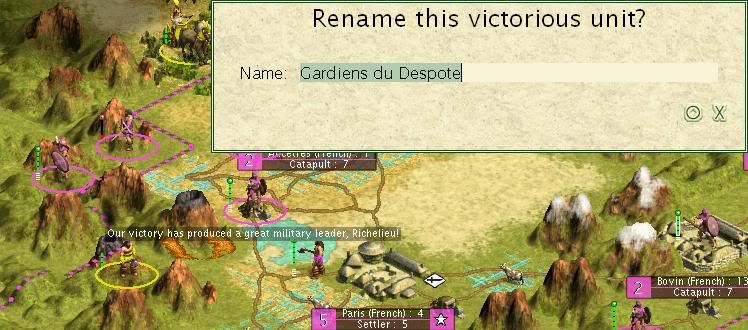
There was another short volcanic eruption, of the Mont des Titans around 630BC. A contingent of Egyptian warriors barely made it to safety.
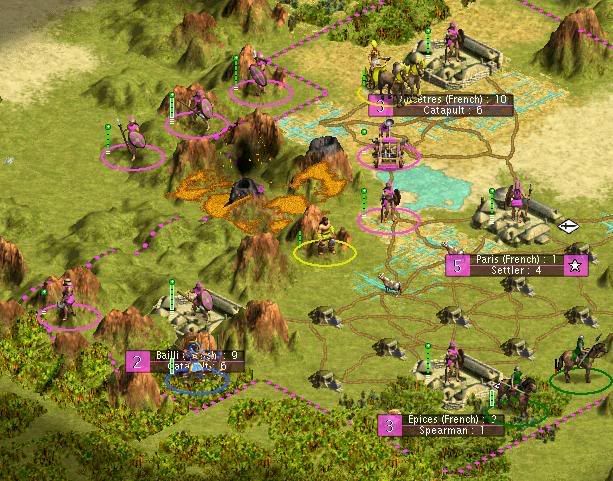
[size=-2]View of the Collines de Bailli in 630BC[/size]
In 570BC, a colony was established at the iron deposits deep within the Chaîne des Loups. The French military might was about to make a steep rise.
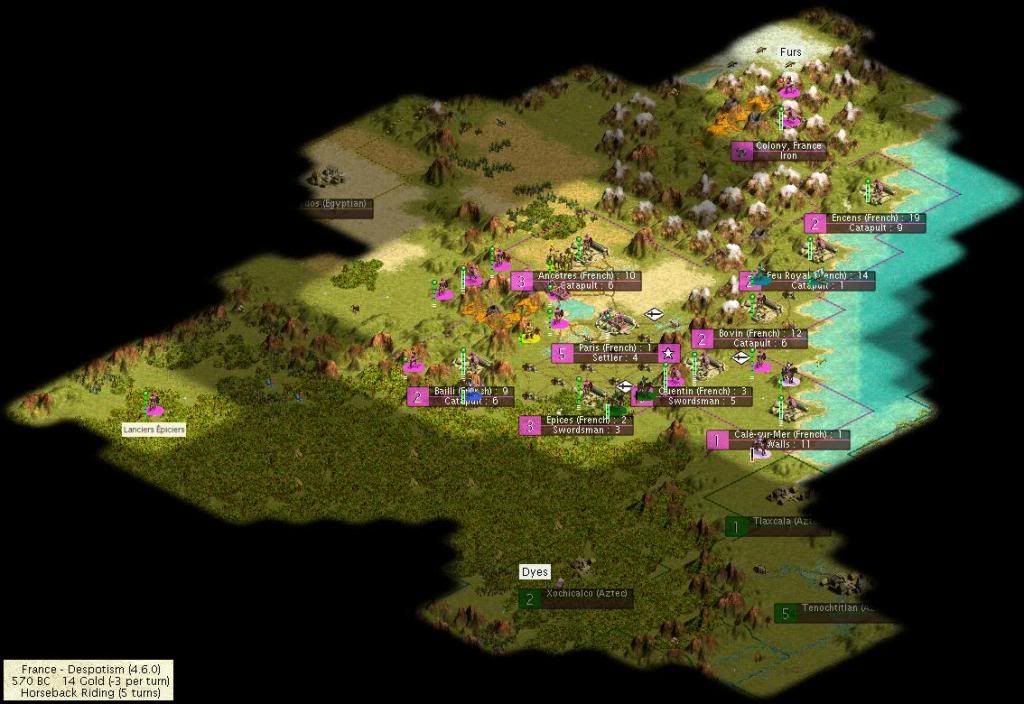
Even though "The First Dark Age" is a grim sounding name, the French people hadn't suffered many setbacks during that period. On the contrary, they were thriving in every respect. GNP and manufacturing had gone up by about 50%, their territorial area by even more than that. Only the population increase had slowed somewhat, but that was mostly due to the formation of many worker crews. Because the French have always kept very precise records of their military and logistics, we know that around 1100BC there were 2 worker crews, and around 570BC there were 7. The number of spearmen divisions had gone from 16 to 23 over the same period, and 9 catapults units had been formed. In Paris, 2 armies were waiting to be deployed.
We know that the period from 1050BC to 750BC was one of rapid territorial expansion. Bailli was founded by Épicier settlers in 1050BC, on the hills overlooking Valbovin. It was the first of four new settlements that would be established in fast succession. The other three were Feu Royal, Encens and Calé-sur-Mer.

[size=-2]Feu Royal was founded in 925BC, on the flanks of Mont Royal and on the board of the eastern ocean[/size]

[size=-2]Encens was founded in 800BC, even further north, in the hills where the incense had been found 450 years earlier[/size]

[size=-2]Calé-sur-Mer was founded in 750BC, wedged in between the Aztec realm to the south and the ocean to the north[/size]
There was also more exploration, especially by the Lancier Épiciers.

[size=-2]Dyes were found near Xochicalco in 900BC[/size]
This expansionist push was possible in part because the influx of enemy units declined during this period. There was continuous fighting, but by then the French military was so well entrenched that the enemy posed no real threat. The only reported loss during this period was a spearman division in the forest near Ancêtres, which was overrun by an Egyptian war chariot.
In 730BC, our knowledge of mathematics was sufficiently developed to build the first catapults. Even though the very first trial on a Persian spearman division failed miserably, more catapults were deployed and they quickly helped to gain an even greater edge on the enemy.
The Wheel was researched in 630BC. The horses that were found in the Chaîne des Loups and north of the Collines de Bailli would soon be put to good use. Research on Horseback Riding was started.


[size=-2]View of the Collines de Bailli in 630BC[/size]

[size=-2]Furs were found just north of the iron deposits[/size]
Starting in 670BC, the fighting intensified again. The French were getting ready to expand again, and their generals were making room for that expansion. In 590BC, the Gardiens du Despote killed an Egyptian archer in a daring move. Their leader, Armand de Richelieu, was granted command of the second French army.

There was another short volcanic eruption, of the Mont des Titans around 630BC. A contingent of Egyptian warriors barely made it to safety.

[size=-2]View of the Collines de Bailli in 630BC[/size]
In 570BC, a colony was established at the iron deposits deep within the Chaîne des Loups. The French military might was about to make a steep rise.
Spoiler World map in 570BC :

Even though "The First Dark Age" is a grim sounding name, the French people hadn't suffered many setbacks during that period. On the contrary, they were thriving in every respect. GNP and manufacturing had gone up by about 50%, their territorial area by even more than that. Only the population increase had slowed somewhat, but that was mostly due to the formation of many worker crews. Because the French have always kept very precise records of their military and logistics, we know that around 1100BC there were 2 worker crews, and around 570BC there were 7. The number of spearmen divisions had gone from 16 to 23 over the same period, and 9 catapults units had been formed. In Paris, 2 armies were waiting to be deployed.



 Always Happy to see your crazy AW's.
Always Happy to see your crazy AW's.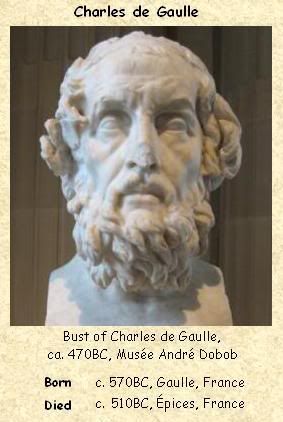
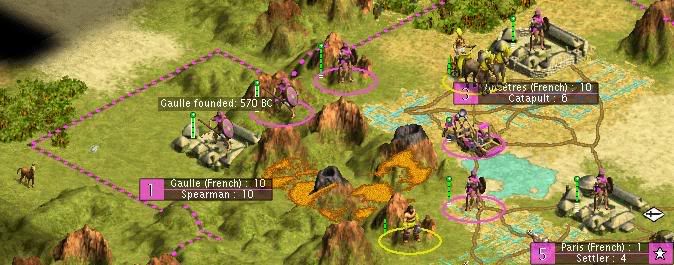
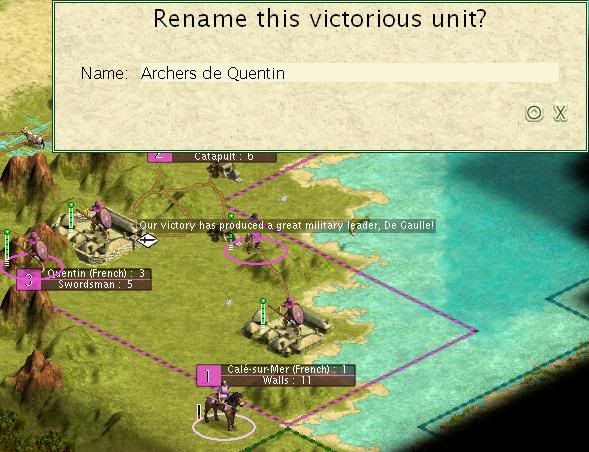
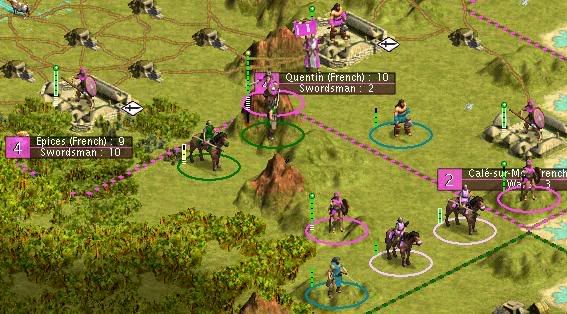
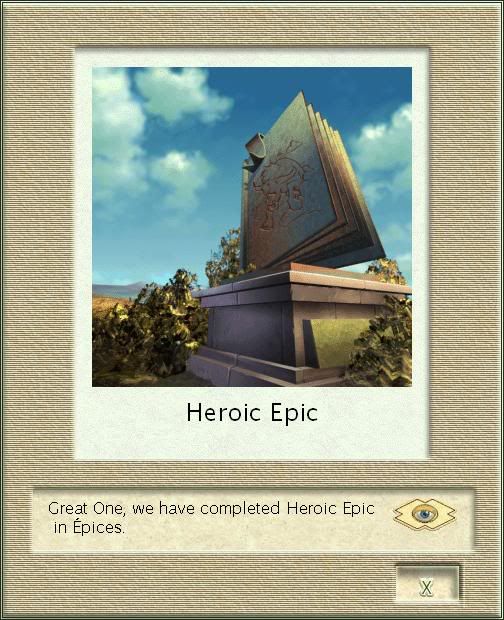
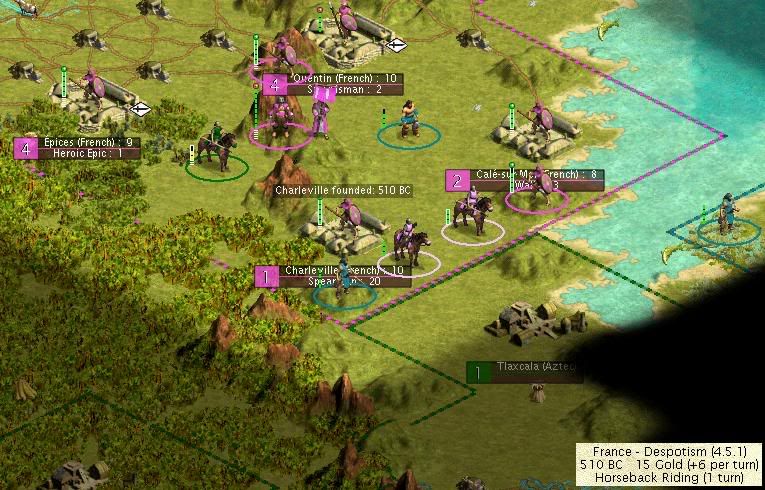
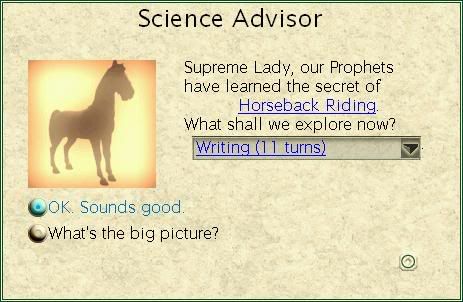


 Again, good luck!
Again, good luck!
